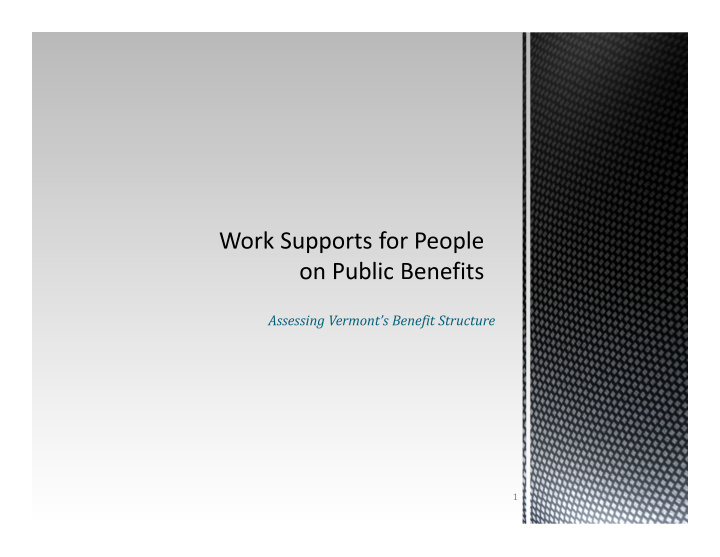



Assessing Vermont’s Benefit Structure 1
Work supports should achieve three goals: Provide adequate family resources. Incentivize work. Reward advancement in the workforce. 2
“The benefits cliff phenomenon can best be characterized as a benefits structure which results in a beneficiary who is receiving multiple economic benefits losing those benefits more rapidly than the rate of increased earnings. At its worst, the “benefits cliff” creates a huge disincentive to work.” - NCCP, 2009 3
3SquaresVT (SNAP). Low Income Heating Emergency. Assistance Program (LIHEAP). TANF Cash Grants. Child Care Financial Assistance. Public Health Insurance. Federal and State Tax Credits. Lifeline Telephone Service Credit. Benefits Not Included in NCCP Analysis: Housing Choice Vouchers (Section 8) 4
In 2011, expanded eligibility of 3SQVT to 185% of FPL and removed assets test for most households. In FY 2011, expanded eligibility of LIHEAP to 185% (from 125%) of FPL and expanded Crisis Fuel Assistance to 200% FPL (from 150%). Child Care Financial Assistance is at 2016 FPL with 90% participation at 100% FPL, but significantly lower as the income goes up. Added a 10% child care subsidy at 300% FPL with the 2016 million dollar allocation and increased infant rates. July, 2015 – expanded Reach Ahead eligibility to two years from one year so the family receives a full child care subsidy and a small nominal benefit ($50 for first 12 months, $5 for last 12 months.) July, 2015 – expanded the earned income disregard from $200+25% to $250+25%. Expanded health care coverage. July, 2017 Reach Up excludes retirement accounts and children’s educational savings accounts. July, 2017 all other non-excluded assets-limit increased from $2000 to $9000. 5
6
Vermont has slowly but steadily increased Work Supports. People are better off going to work at the current minimum wage than staying on Reach Up although they may still be struggling economically. Research shows that supplementing earnings encourages people to work and increases their income when they do (MDRC, 2004). People are better off if the minimum wage goes from $10 to $12.50 if they don’t need child care. People are worse off if the minimum wage goes from $10 to $12.50 if they need child care and receive the subsidy to pay for it. Families that are between 100% and 300% FPL and need child care and the subsidy tend to lose ground as wages increase. The work disincentive is due do a decline in benefits but childcare is the biggest contributor to the slope as wages increase. 7
9
Single Person Benefits Phase Out 100% - 200% FPL 50,000 Combined Earnings + Benefits 40,000 30,000 20,000 10,000 0 Earned Income Benefits BNB Min Wage
One Working Parent + One Child Benefits Phase Out 100% -200% FPL 50,000 40,000 30,000 20,000 10,000 0 Earned Income Benefits Min Wage BNB
One Working Parent + One Child Benefits Phase Out 120% -220% FPL 50,000 40,000 30,000 20,000 10,000 0 Earned Income Benefits New Benefits Min Wage BNB
Recommend
More recommend